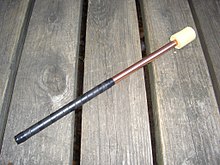Torch

A torch is a portable source of light, usually battery powered, known as a "flashlight" in the USA and Canada. Before the advent of the modern torch (or flashlight), a torch was traditionally a rod-shaped piece of wood with a rag soaked in pitch and/or some other flammable material wrapped around one end. Torches were often supported in sconces by brackets high up on walls, to throw light over corridors in stone structures such as castles or crypts. This traditional use of the word lives on in the Olympic Torch, procession torches and the like.
In Britain, a torch which uses fire as its light-source is often called a "burning torch", to distinguish from the modern use of the word "torch" used in all English speaking countries except North America.
A torch carried in relay by cross-country runners is used to light the Olympic flame which burns without interruption until the end of the Games. These torches and relay tradition were introduced in 1936 Summer Olympics by Carl Diem, chairman of the event because during the duration of the Ancient Olympic Games in Olympia, a sacred flame burns inside of the temple of Hera, kept in custody by her priestess.
If a torch is made of sulfur mixed with lime, the fire will not diminish after being plunged into water. Such torches were used by the ancient Romans.
Procession torches are made from coarse hessian rolled into a tube and soaked in wax. There is usually a wooden handle and a cardboard collar to deflect any wax droplets. They are an easy, safe and relatively cheap way to hold a flame aloft in a parade, or to provide illumination in any after-dark celebration.

Juggling torches are often used as a prop in toss juggling: they can be flipped into the air in an end-over-end motion while being juggled, in the same manner as juggling clubs or juggling knives, but because of their sound and 'trail of flame', they can appear much more impressive to audiences. To a skilled juggler, there is only a slight chance of being burned, but they are still dangerous.
Symbolism
The torch is a common emblem of both enlightenment and hope. Thus the Statue of Liberty, actually "Liberty Enlightening the World", lifts her torch. Crossed reversed torches were signs of mourning that appear on Greek and Roman funerary monuments—a torch pointed downwards symbolizes death, while a torch held up symbolizes life, truth and the regenerative power of flame. The torch is also a symbol used by political parties such as the British Conservative Party (who exchanged it for an oak tree in 2006) and the Malta Labour Party. In the seals of schools in the Philippines, the torch symbolizes the vision of education to provide enlightenment to all the students.
In Roman Catholic liturgy
In former times, liturgical torches were carried in Eucharistic processions simply to give light. The Church eventually adopted their use for Solemn High Masses.
According to Adrian Fortescue ("The Mass: A Study of the Roman Liturgy [1912]"), the more correct form of liturgical torches are non-freestanding (i.e. cannot stand up on their own). However, today, even in the Vatican, freestanding, tall candles in ornate candle-stick holders have replaced the former type. The torches are carried by torchbearers, who enter at the Sanctus and leave after Communion.
Anglicans of the High Church and some Lutherans use torches in some of their liturgical celebrations as well.
Idiom "carry a torch for"

The idiom to "carry a torch for" someone means to love or to be romantically infatuated with someone, especially when such feelings are not reciprocated. It is often used to characterize a situation in which a romantic relationship has ended, but where one partner still loves the other. It is considered by some to be dated,[1] but still in wide usage.
Etymology
The association of a torch with love may date to the Greek and Roman tradition of a wedding torch,[2] lit in the bride’s hearth on her wedding night, then used to light the hearth in her new home. Such a torch is associated with the Greek god of marriage Hymenaios.
Image gallery
-
Torch seller, tacuinum sanitatis casanatensis (XIV century)
See also
References
External links
- Picture of non-freestanding torches Antique Liturgical Torches in Procession
- Picture of non-freestanding torches Antique Liturgical Torches in Procession



